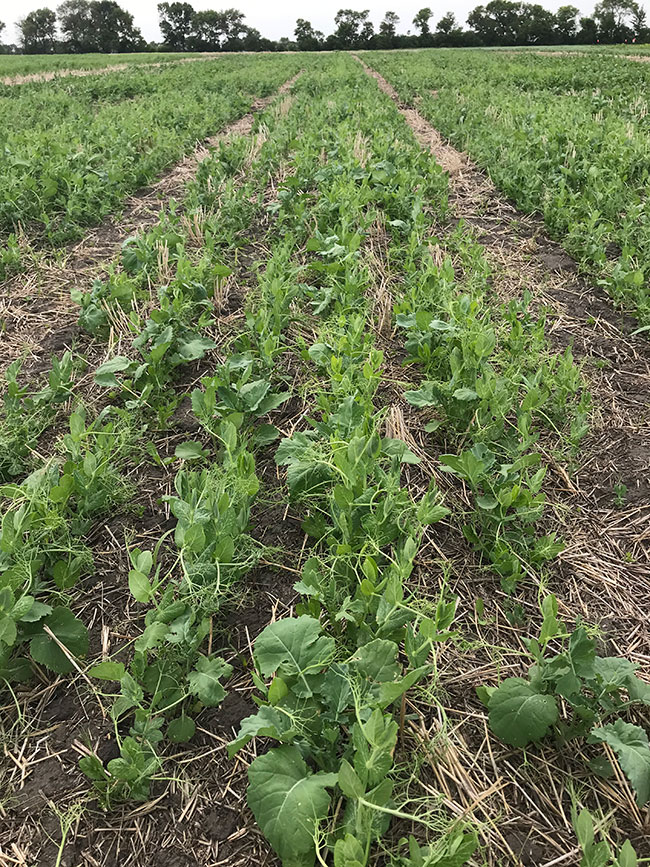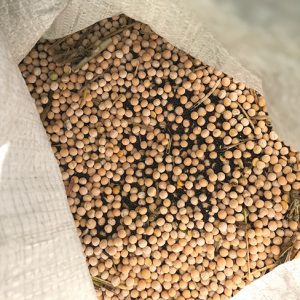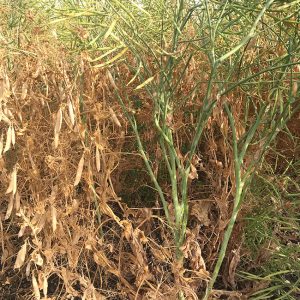
Features
Pulses
Canola
Understanding peaola
Think of it as a way to improve pea production.
November 26, 2020 By Bruce Barker
 Peaola is about growing a better pea crop.
Photos courtesy of Scott Chalmers.
Peaola is about growing a better pea crop.
Photos courtesy of Scott Chalmers. Who wants change for the better? Most people do. But who wants to change? That’s a tougher question, especially as it relates to intercropping a mixture of pea and canola. While some farmers are making that change, the big production barrier is the need to clean peaola production at harvest – a bottleneck that can slow harvest progress.
“The way I look at peaola is that it is a better way to grow peas, while canola is a less important part of the production system. If you’re going to compare peaola to monocrop canola, any time canola prices are strong, canola is going to win on profitability,” says Scott Chalmers, diversification specialist with the Westman Agricultural Diversification Organization (WADO) in Melita, Man.
Chalmers has a large body of peaola research that goes back to 2009 looking at seeding rates, nitrogen and phosphate application, row orientations, fungicide applications, and intercrops of pea with crops other than canola. He is continuing research in 2020 and beyond to further refine peaola production.
The main consideration is whether more money can be made with pea and canola grown together. Chalmers has found that moisture drives the benefits of peaola yield. He says when moisture is adequate to above normal, generally intercrops perform better together than as monocrops. Chalmers has found that intercrops use more water, such as in pea-canola. “Perhaps in 2011, when we had excessive moisture, the intercrops performed better as they were more able to survive heavy rainfalls, whereas the monocrops were more prone to waterlogging.”
He says timing of the moisture is also critical. It must be present for both crops at peak growth periods. If this does not happen, the other crop will “cannibalize” the resources. For example, peas will have the upper hand if the early spring is dry.
Profits also vary more if it is dry because the yield potential is not there, and there is the additional cost of separating the seed.
“If canola markets are in favour of the farmer, then it makes sense to fertilize monocrop canola to its potential rather than working within the small marginal benefits of peaola, or conversely when pea margins are low. However, when pea prices are strong and canola is average to below average, this peaola systems makes more sense,” Chalmers says.
Chris Holzapfel, research manager with the Indian Head Agricultural Research Foundation (IHARF) in Indian Head, Sask., also researched peaola production from 2010 through 2012 with five site-years of data. Generally, he saw the same interactions of yield potential and commodity prices on peaola profitability.
“I agree profitability would depend a lot on relative commodity prices and, in general, monocrop canola can be a tough one to compete against when it has decent yields and prices,” Holzapfel says. “I have suggested in the past that perhaps growing a type of pea that is higher value but difficult to grow as monocrops (i.e. Maple peas) might make more sense than using yellows, which are generally lower value and well adapted to monocrop when using modern varieties.”
Advantages of peaola
Over the last decade of research, Chalmers and Holzapfel have seen agronomic advantages and disadvantages of peaola:
- Mixed rows offer higher yield than alternate rows, and less so paired or triple rows of individual crops – the thought was there would be less competition between the crops in separate rows, or that canola would receive preferential access to N. This wasn’t the case.
- Applied nitrogen has little effect on overyielding of the system. Adding N fertilizer favoured an increase in canola yield but not pea yield. Nitrogen fertilization also reduced the number of pea nodules and N fixation. Chalmers doesn’t recommend N fertilizer when targeting higher pea yield in the peaola crop.
- Applied phosphorous (in deficient soils) provided additional peaola yield benefits, and produced more pea nodules with increasing rates. Yield of both pea and canola were increased, with overall grain production rising from 43 bushels per acre with no added P to a significantly higher yield of 49 bushels per acre with 30 pounds of P2O5 per acre in two years of trials at WADO.
- Peaola offers significant protection against pea aphid infestations compared to monocrop peas. WADO research found that monocrop pea had about 16 aphids per plant in 2017 compared to about two aphids in peaola stands.
- In a peaola crop, peas stand taller to allow a higher cutting height. In addition to ease of harvest, the stubble left behind after harvest can catch more snow compared to monocrop pea. Monocrop pea often has little standing stubble left and can be prone to soil erosion and “spring drought.”
- Peaola can reduce seedborne disease from Ascochyta compared to monocrop peas. In WADO research, monocrop pea had 16.5 per cent Ascochyta diseased seed compared to 2.25 per cent when peaola was sown in single rows.
- Clearfield canola is grown in peaola crops so that Odyssey herbicide can be used for weed control. The denser peaola stand can mean a more competitive crop and improved weed control than in monocrop pea.
- Experience has shown that pea is more frost-tolerant than canola in the peaola crop. This can offer “intrinsic” crop insurance against spring frost in peaola stands so that, if the canola is damaged by frost, the pea crop may still continue to grow so that the farmer doesn’t have to reseed their field.
- WADO research found that broadcasting alfalfa before or after seeding peaola established a satisfactory stand of alfalfa. The addition of alfalfa may provide an advantage on saline, saturated areas where peas or canola do not grow well. Chalmers says these benefits are difficult to measure in small plots but may be realized in field-scale conditions.
- Pea and canola have complimentary rooting depths. Pea is shallow-rooted while canola’s taproot reaches much deeper into the soil profile. This allows peaola to more thoroughly access soil moisture deeper in the soil profile than pea alone, and may offer a way to reduce salinity and grow more crop during excessive moisture conditions.
Peaola disadvantages
- Extra work seeding and separating crops, leading to extra labour or time.
- Bottlenecks during harvest at the separator.
- Somewhat more wasteful on inoculant inputs (compared to monocrops) if a granular type is used.
- Fewer weed control options, since LibertyLink and Roundup Ready varieties cannot be grown, unless Edge is used for pre-emergent weed control. The Clearfield canola option is challenged by Group 2 resistance found in kochia, cleavers, barnyard grass, chickweed, cow cockle, yellow foxtail, hemp-nettle, lamb’s-quarters, ball mustard and wild mustard.
- Canola rotations are already very tight in Western Canada, and adding canola to a pea crop means the rotations are tightened further. This can result in an increased risk of diseases like blackleg and clubroot in canola, or Aphanomyces in pea.
A possible solution to the cleaning bottleneck at harvest is to store peaola until after harvest and then separate the crops. For example, if both crops are dry – canola at nine per cent and pea at 15 per cent – PAMI suggests the crops could be safely stored until they can be separated. They have done some theoretical calculations on peaola based on the equilibrium moisture content relationships of each grain type; if both monocrops are considered dry and cool (less than 15 C) when stored, then the risk of moisture migration between the two crop types should be low.
“We have just proposed a research project to a funder to answer this exact question for peaola storage and other intercrop combinations as well,” says Charley Sprenger, project leader with Prairie Agricultural Machinery Institute (PAMI) in Portage la Prairie, Man.
Overall, peaola is working for some farmers, but it isn’t for everyone. “Don’t compare peaola to monocrop canola, because canola is such a monster crop. Peaola is really about the pea crop and growing [it] as an intercrop can help improve pea profitability when pea prices are strong,” Chalmers says.

